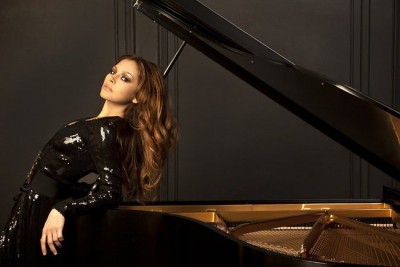
MISO opens season Sunday at Knight Concert Hall
This Sunday, the Miami Symphony Orchestra opens another season at the Knight Concert Hall, in an evening of canonical works by Mendelssohn, Brahms and Rachmaninov.
Conductor Eduardo Marturet will lead the orchestra in the Calm Sea and Prosperous Voyage overture of Mendelssohn, Brahms’ First Symphony and the Rhapsody on a Theme of Paganini by Rachmaninov, with the Russian-American pianist Lola Astanova as the soloist.
Astanova, who also will play the Rhapsody with the Palm Beach Symphony in March of next year, is one of the numerous classical musicians who’ve made a splash by the videos they’ve posted on YouTube. In Astanova’s case, it was her performance of her own Lisztian-style transcription of Rihanna’s Don’t Stop the Music that went viral. It’s a clever reimagining of the song, and works well as a virtuoso recital encore.
As her publicity materials make clear, Astanova is also something of a fashion plate, and she makes the most of her considerable physical beauty and her ability to look chic in a wide range of styles to make her appearances “an event,” as she once told me. That tends to obscure her facility at the keyboard and her very serious approach to music, but it also seems to me an almost unavoidable melding of the glitzy and the elevated that seems to be all over our artistic culture these days.
Still, she’s worth hearing; I’ve enjoyed her performances here in South Florida, and I still look forward to hearing her in smaller recital or chamber music settings at some point down the road. (Here she is one of Chopin’s loveliest mazurkas, Op. 33, No. 4.)
The Rhapsody is one of Rachmaninov’s finest pieces — his compatriot and friend Vladimir Horowitz thought it was his best — in no small part because its variation structure, which uses the 24th solo caprice for violin by the early 19th-century virtuoso Nicolò Paganini as its theme, keeps the Russian composer from prolixity. It also allows him to show off a much wider range of his formidable ability to orchestrate, which is heard less in the piano concerti than it is in works such as the Symphonic Dances that closed his career.
The Rhapsody is also well-known for its 18th variation, which takes the first part of Paganini’s theme, turns it upside-down, recasts it in the major and slows the tempo. Rachmaninov famously remarked that he was composing the variation “for my manager,” and he was right about its appeal: It became hugely popular shortly after its 1934 premiere, and has helped keep the Rhapsody firmly in the repertoire since then.
Rachmaninov had a busy life right up until the end. He had left Russia during the Revolution of 1917 after the Bolsheviks seized his property, and moved to the United States in 1918, where he lived in a townhouse on Riverside Drive in New York. He later had a villa in Switzerland and a home in Beverly Hills, Calif., where he died of cancer in March 1943. He’s buried in Valhalla, N.Y., not far from the big city, and there’s also a monument to him in Knoxville, Tenn., where he gave his last recital the month before his death, and became too ill afterward to continue his concert tour and returned to Los Angeles.
He had to work constantly from the time he left Russia until his death, and it seems a shame that he found so little time for composition during those crowded years between the wars. But he did write the Rhapsody, and its compactness, clarity of design, plus its abundance of memorable melody and brilliant pianistic display, make it a fitting monument as well as a most attractive work of living art.
The Miami Symphony Orchestra performs at 6 p.m. Sunday in the Knight Concert Hall. Call the Arsht Center at 305-949-6722 for tickets or visit www.arshtcenter.org.
Recent Content
-
Artsarticle ·
-
Artsarticle ·
-
Artsarticle ·

